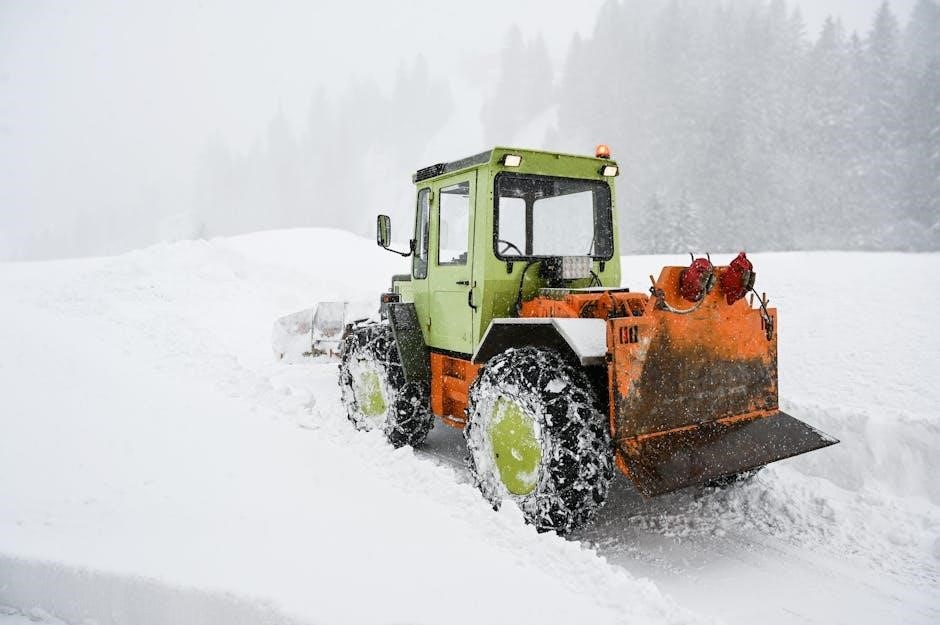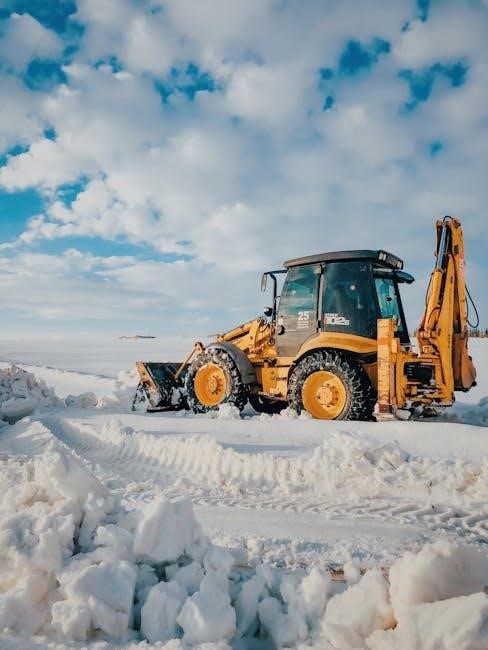Western snow plows are essential for winter maintenance, ensuring safety and efficiency․ Troubleshooting is crucial to address common issues like blade malfunctions and hydraulic system failures promptly․
1․1 Importance of Regular Maintenance
Regular maintenance is crucial for Western snow plows to ensure reliability and performance during harsh winter conditions․ It prevents unexpected breakdowns, reduces repair costs, and extends equipment lifespan․ Proper upkeep addresses potential issues before they escalate, ensuring safety and efficiency․ Consistent checks on hydraulic systems, electrical components, and blade alignment are essential to maintain optimal functionality and avoid downtime when plowing is critical․
1․2 Common Issues Faced by Users
Western snow plow users often encounter blade malfunctions, hydraulic system failures, and electrical connectivity problems․ These issues can lead to reduced performance and safety risks․ Additionally, users may face challenges with angle cylinder failures, uneven blade wear, and control system glitches․ Identifying and addressing these problems promptly is essential to maintain efficiency and ensure reliable operation during snowy conditions․
Identifying Common Problems with Western Snow Plows
Common issues with Western snow plows often manifest through unusual noises, reduced performance, or system errors․ Regular inspections and diagnostic tools help identify root causes efficiently․
2․1 Blade Malfunction and Adjustment Issues
Blade malfunctions, such as uneven plowing or improper angle adjustments, often stem from misalignment or worn components․ Hydraulic system leaks or sensor failures can also disrupt blade functionality․ Regular inspections and timely repairs are essential to maintain optimal performance and avoid costly downtime during winter operations․
2․2 Hydraulic System Failures
Hydraulic system failures in Western snow plows often occur due to fluid leaks, pump malfunction, or blockages․ Low fluid levels, contaminated oil, or faulty valves can also cause pressure drops․ Regular inspection of hoses, seals, and cylinders is crucial to prevent sudden system failures․ Addressing these issues promptly ensures consistent plowing performance and avoids costly repairs during critical winter operations․
2․3 Electrical System Faults
Electrical system faults in Western snow plows can lead to blade malfunction, poor lighting, or complete system shutdown․ Common issues include corroded connectors, faulty sensors, or damaged wiring․ Troubleshooting involves checking for blown fuses, testing circuit continuity, and ensuring proper connections․ Addressing electrical faults promptly prevents downtime and ensures reliable performance during snow removal operations․
Diagnostic Steps for Western Snow Plows
Diagnostic steps for Western snow plows involve systematic checks, visual inspections, and testing of components․ Utilize diagnostic tools to identify issues efficiently and ensure proper functionality․
3․1 Pre-Troubleshooting Checks
Before diagnosing issues, perform visual inspections of the plow, blade, and hydraulic system․ Check fluid levels and battery connections․ Ensure all safety features are functioning․ Verify proper blade alignment and test control functions․ Review the operator’s manual for specific pre-check procedures․ Address any visible damage or wear․ This step ensures a systematic approach to identifying potential problems efficiently․
3․2 Using Diagnostic Tools Effectively
Utilize diagnostic tools like multimeters for electrical circuits and hydraulic pressure testers for system performance․ Manufacturer-provided software can help identify faults in real-time․ Always refer to the operator’s manual for specific diagnostic procedures․ Systematically test components to isolate issues, ensuring accurate troubleshooting․ Regularly calibrate tools to maintain reliability․ Effective use of these tools reduces downtime and ensures precise repairs, optimizing plow performance during critical winter operations․

Essential Tools and Spare Parts for Troubleshooting
Keep a multimeter, wrench set, and hydraulic pressure tester on hand․ Essential spare parts include hydraulic hoses, seals, and plow blade components․ Always maintain a stockpile of fuses, wiring connectors, and light bulbs for quick electrical repairs․ These tools and parts ensure efficient troubleshooting and minimize downtime during winter operations․
4․1 Must-Have Tools for Repairs
For effective Western snow plow repairs, essential tools include a multimeter, torque wrench, pliers, and a hydraulic pressure tester․ Keep a set of wrenches, screwdrivers, and pliers handy․ A pressure gauge is vital for diagnosing hydraulic issues․ Insulated gloves and safety goggles ensure protection during repairs․ Additionally, a well-organized toolbox with spare fuses, wiring connectors, and a circuit tester can help resolve electrical faults quickly․ These tools are crucial for minimizing downtime and ensuring safety․
4․2 Recommended Spare Parts to Keep Handy
Keeping essential spare parts on hand ensures quick repairs and minimizes downtime․ Recommended items include hydraulic hoses, seals, and O-rings to address fluid leaks․ Extra blades and cutting edges are crucial for wear-related issues․ Store electrical components like fuses, wiring connectors, and relays for rapid fixes․ Additionally, maintain a stock of fasteners, springs, and greases to tackle common mechanical failures efficiently․ These spares help restore functionality swiftly․

Safety Tips for Troubleshooting Western Snow Plows
Always wear protective gear, ensure the plow is on a level surface, and disconnect power sources before starting repairs․ Use jack stands for stability and follow the manufacturer’s guidelines to avoid accidents․
5․1 Precautions Before Starting Repairs
Before troubleshooting your Western snow plow, ensure the vehicle is on a level surface and engage the parking brake․ Disconnect the battery to prevent accidental startups․ Wear protective gear, including gloves and safety glasses․ Check for any fluid leaks or loose components․ Use jack stands for added stability if lifting the plow․ Always follow the manufacturer’s safety guidelines and ensure the area is clear of bystanders․ Stay vigilant for moving parts and avoid overreaching․
5․2 Best Practices for Safe Maintenance
Regular inspections and routine maintenance are key to ensuring safe and efficient snow plow operation․ Always use appropriate tools and follow manufacturer guidelines․ Document all services and repairs for future reference․ Address minor issues promptly to prevent major failures․ Train operators on safety protocols and equipment handling․ Stay updated with the latest maintenance techniques and safety standards to minimize risks and optimize performance throughout the winter season․

Step-by-Step Guide to Resolving Common Issues
Identify the problem, use diagnostic tools, and apply targeted solutions․ Follow a systematic approach to resolve issues efficiently and safely, ensuring optimal snow plow performance․
6․1 Fixing Blade Alignment Problems
Start by ensuring the plow is on a level surface and engage the parking brake․ Measure the blade’s position to check for even alignment․ Loosen adjustment bolts, realign the blade to ensure it’s parallel and centered, then tighten the bolts․ Test the plow’s movement to confirm proper alignment․ If issues persist, inspect for wear and tear, and consider professional assistance for accurate adjustment․
6․2 Repairing Hydraulic Leaks and Pressure Issues
Identify hydraulic leaks by inspecting hoses, connections, and cylinders for fluid loss․ Tighten loose fittings and replace damaged seals or components․ Check fluid levels and top up as needed․ Inspect pressure gauges for abnormal readings and ensure valves function properly․ If issues persist, consult the manufacturer’s guidelines for system-specific repairs․ Always ensure the system is depressurized before starting any hydraulic work to maintain safety․
6․3 Solving Electrical Connectivity Problems
Begin by inspecting wiring harnesses and connections for corrosion or damage․ Clean corroded terminals and replace any faulty wires․ Ensure all connectors are securely attached and not loose․ Use a multimeter to test for voltage drops or shorts in the circuit․ Apply dielectric grease to protect connections from moisture․ If issues persist, consult the wiring diagram or contact a certified technician for assistance․ Always disconnect the battery before performing electrical repairs for safety․

Preventative Maintenance Tips
Regularly inspect and lubricate moving parts, check hydraulic fluid levels, and ensure blade alignment is correct․ Schedule pre-season inspections and store equipment properly post-season․
7․1 Scheduling Regular Inspections
Regular inspections are vital for maintaining Western snow plows․ Schedule pre-season checks to identify wear and tear, and ensure all components are functioning properly․ Mid-season inspections help catch issues before they escalate, while post-season evaluations prepare the equipment for storage․ Consistent inspections prevent unexpected breakdowns and extend the lifespan of your snow plow, ensuring reliability during harsh winter conditions․
7․2 Tips for Extending Equipment Lifespan
To extend the lifespan of your Western snow plow, prioritize proper storage, lubrication, and timely repairs․ Regularly clean and inspect blades, and replace worn parts promptly․ Use manufacturer-recommended fluids and follow seasonal maintenance routines․ Avoid overloading the plow and ensure operators are well-trained․ These practices reduce wear and tear, ensuring optimal performance and longevity of the equipment through multiple winter seasons․

Advanced Troubleshooting Techniques
Advanced troubleshooting involves using specialized diagnostic tools and techniques to identify complex issues efficiently․ These methods ensure precise problem-solving, minimizing downtime and enhancing overall equipment performance․
8․1 Using Manufacturer Guidelines
Manufacturer guidelines are essential for effective troubleshooting of Western snow plows․ These documents provide detailed instructions, diagrams, and specifications tailored to the equipment․ By following these guidelines, users can identify and address issues accurately․ They often include troubleshooting charts, diagnostic codes, and recommended repair procedures․ Adhering to these guidelines ensures safety, efficiency, and compliance with the manufacturer’s standards․ Regularly updating with the latest manuals is crucial for optimal results․
8․2 When to Seek Professional Help
If issues with your Western snow plow persist despite troubleshooting, it’s important to seek professional help․ Complex problems like severe hydraulic leaks or electrical faults may require specialized tools and expertise․ Certified technicians can diagnose and repair issues efficiently, ensuring long-term functionality․ They also provide warranties and guarantees, giving you peace of mind․ Don’t hesitate to contact authorized service centers for assistance when needed․
Effective troubleshooting and regular maintenance are key to ensuring your Western snow plow operates efficiently․ By addressing issues promptly, you can enhance safety, productivity, and equipment longevity․
9․1 Summarizing Key Troubleshooting Strategies
Effective troubleshooting involves a systematic approach, starting with prechecks and diagnostics․ Always prioritize safety, use specialized tools, and refer to manufacturer guidelines․ Address blade alignment, hydraulic leaks, and electrical connectivity issues promptly․ Regular maintenance and proactive inspections can prevent major breakdowns․ By following these strategies, you ensure optimal performance and extend the lifespan of your Western snow plow equipment․
9․2 Encouraging Proactive Maintenance
Proactive maintenance is vital for maximizing the efficiency and longevity of your Western snow plow․ Regular inspections, timely repairs, and adherence to manufacturer recommendations ensure equipment reliability․ By scheduling routine checks and addressing minor issues before they escalate, you can prevent costly downtime and enhance overall performance during critical winter operations․